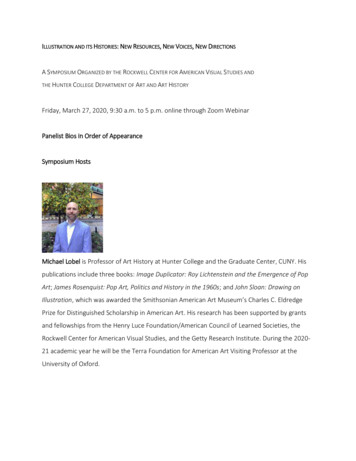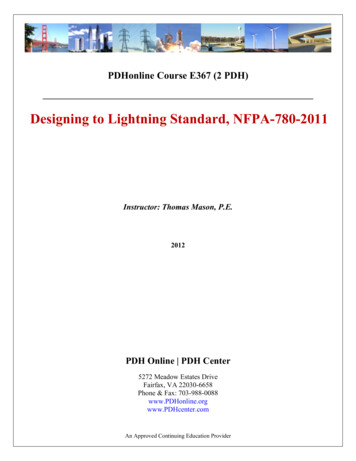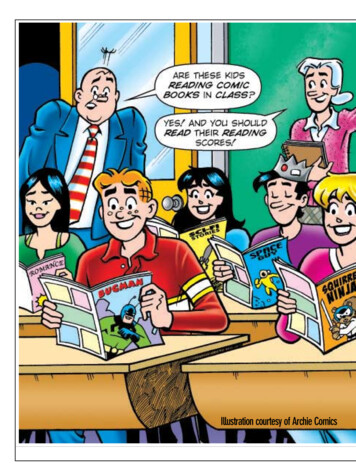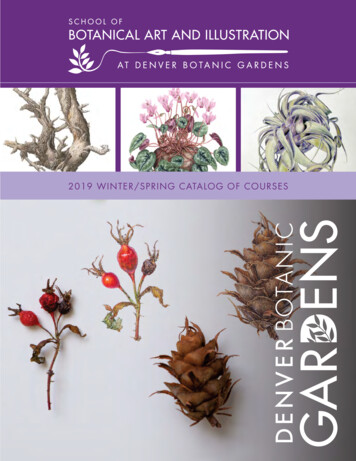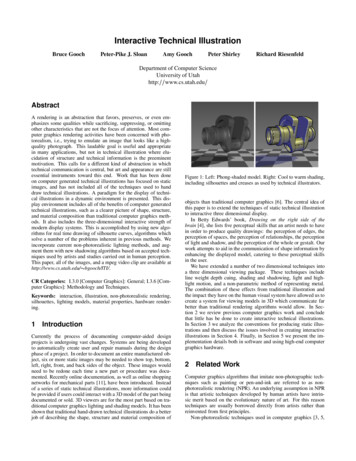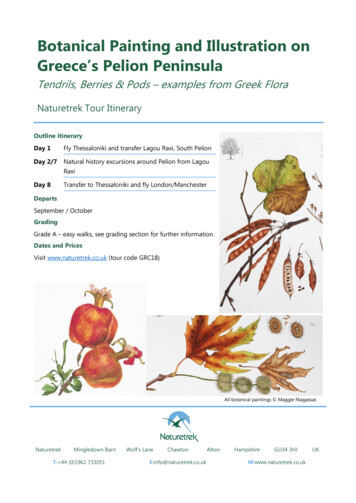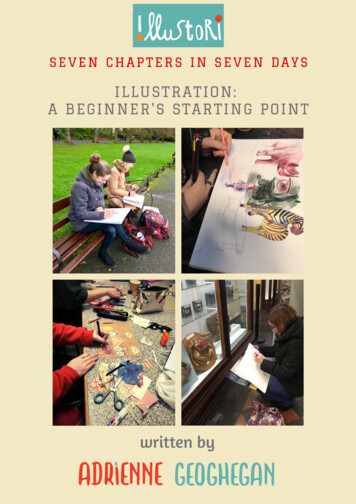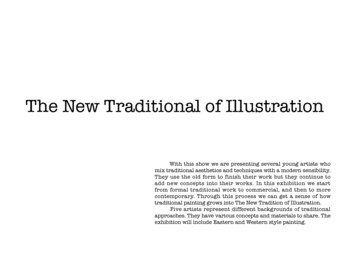
Transcription
The New Traditional of IllustrationWith this show we are presenting several young artists whomix traditional aesthetics and techniques with a modern sensibility.They use the old form to finish their work but they continue toadd new concepts into their works. In this exhibition we startfrom formal traditional work to commercial, and then to morecontemporary. Through this process we can get a sense of howtraditional painting grows into The New Tradition of Illustration.Five artists represent different backgrounds of traditionalapproaches. They have various concepts and materials to share. Theexhibition will include Eastern and Western style painting.
Yuanjin Wei,graduate from Curator Talk:Guangzhou Academy of FineArt major in Art Education.Now i s a M FA i l l u s t r a t i o npractice student. Her worksare mainly focused on ChineseTraditional painting combinedwith contemporary content. Ialways have some new conceptin my mind and I love to usethe old for m to express it.Mix the Eastern and Westernculture together will be my goalof illustration.We a r e h a v i n g f i v ea r t i s t s r e p r e s e n t d i f fe r e n tbackgrounds of tradition, theyhave various kind of conceptsand materials spread beforeus. The exhibition will includeEaster n and Wester n style.First it will focus on the realtraditional work, which is LiJin who used rice paper andink and Chinese color. ThenYoko shumizu uses the samematerials. She has a strongsocial connection in her workbecause it had a commercialviability. In the middle will havea connetion between Easternand Wester n style which isTenmyouya Hisashi. He usedthe Western material such asacrylic combined with Easternway of the gold leaf on thebackground to complete hiswork. Next will be Western, LiuYe’s works used the traditionaloil painting way but thecartoon like painting. Last, isTodd Conoverused who usedthe tradition image with newform of collage that combinedlayers of paper.
Formal traditional workLi JinLi Jin is doesn’t just portray the human form withall its imperfections and blemishes, but he celebratesthem. Relishing in the banal, he focuses on everydayactivities such as bathing, eating, reading or simplydoing nothing at all. His subjects, more often thannot, appear to be caught by surprise; rather as thoughsnapped by an intruding photographer not that thisseems to bother them.- Celina Teague
Li JinHealthy Life 2004Chinese brush, ink and grass paperThis artwork is a self-portrait,with Li Jin drawing while seated at abamboo desk on a bamboo chair. Plantsand trees surround him, as thoughhe is in nature. In the city peopleusually have fancier sofas or desks.He is painting a fish. Li Jin representslife in the traditional manner, but thecharacter’s cloths are contemporary,and the composition of the pictureis more western, with the desk andchair extending beyond the painting.People live in a rapidly moving world,but in the Chinese tradition, peoplewere encouraged to calm down anddraw something peaceful so that theymight develop a healthier life. For theChinese, “Healthy Life” means to livewithin a simpler tradition.
Li JinUntitled 200722 x 88cm Chinese brush, ink and rice paperIn China, it is said that: “Eatingis the sky of the life”, Li Jin randomlydraws a variety of food surroundedwith the words that explain themethods to cook the food. The formof the painting is avant-garde for aChinese traditional painting. In thetraditional form, an object and itstext are next to each other, with someblank space left for the imagination.Li Jin used words to fill the emptyspaces, although some parts of wordsare jumbled. He used the traditionalfree hand br ush to represent thecontemporar y food. This paintingseems to illustrate the artist livingnatural and unrestrained.
“Diet male and female picture”focuses on human living, food andthe relationship between male andfemale. In this work there are twotypical Chinese people, as Li Jinsaid: “normal people paint regularpainting.” The table behind them holdsa hot pot meal, which is somethingof contemporary life, this traditionalpainting. Li Jin takes a snapshot of amoment, including facial expressionsand object details of today’s world.Li JinDiet male and female picture,200945.5x49cm Chinese brush, ink and rice paper
Commercial TraditionYuko ShimizuYuko Shimizu is a freelance illustrator lives andworks in New York City. She works in a studio withtwo other illustrators whom she considers a her NewYork family. She often creates charged science-fictionfantasies and personal creative visions which deftly meldtraditional Japanese graphics with surrealism and comicculture.She each project with classic methods drawingher basic forms and figures with Japanese calligraphybrushes and later digitally supplementing them withadditional colors and backgrounds creating a sense ofelegantly and harmoniously composed images the look ofgraphic prints.
Yuko Shimizu made this picturefor The Word magazine (UK) monthlysupplement CD, Now hear this! Herwork focuses on the imagination. Thepicture shows a full moon over anarched bridge straight out of Hiroshigeand a half-clothed tattooed womanholding a boom box on her shoulder.Here we recognize the strong Japaneseinfluences. With its artful mixture ofold and new this work shocks with theunexpected juxtapositions.Yuko ShimizuNow hear this! Cover for October issue 2007Japanese calligraphy brush, ink, digitally supplementing color
Yuko ShimizuPanda Bear Girl, 2004Japanese calligraphy brush, ink, digitally supplementing colorIn this painting, a girl is dressedlike a panda bear, taking out hersword to face the arrows flying at her.Behind the panda bear girl, are imagesof Fujiyama Japan’s famous volcanoand the skyline of New York City. Itrefers to how Yuko Shumizu went toNew York City alone. There she metdifferent situations, but she was braveand used her own weapon to deal withthem. This work portrays her imaginedheroism. The background shows thatthe two cultures can get along witheach other. Yuko Shumizu also usedthe Japanese comic composition togive this painting more drama andinterest.
Yuko ShimizuOn new movie letters form two jima, Entertainment Weekly year end issue 2006Japanese calligraphy brush, ink, digitally supplementing colorThe Clint Eastwood film, Lettersfrom Iwo Jima, inspired this artwork.In the painting we can see a Japanesearmy officer handing over a letterto a demure Japanese woman in theforeground who may be either a wifeor a mother. They are portrayed inprofile so that we can focus on theJapanese soldiers struggling throughcurling waves in the backg round.Further in the background, Iwo Jimastands against the Rising Sun f lag.Overhead several bombers fly throughblossoming cherry trees. Two panelsat the top right display the name ofthe film and the director. This workrefers to the movie, from a Japaneseperspective.
In this illustration, two menwearing neckties and shirts tuckedinto boxing horts. Below the knees,the grey haired man’s legs are bare,while the man in glasses has a pairof samurai shin guards. Under theirfeet are the suits representing theircultures, a cape and the samurai suit.This cover illustration refers to thenotion that it is time western andeastern people fight together againsttheir common enemy: Money. Standingback to back in comic form, YukoShumizu illustrated how the peoplefrom different cultures may stand onthe same side.Yuko ShumizuPortrait of two Nomura executives, EUROMONEY (UK) October 2009 issue coverJapanese calligraphy brush, ink, digitally supplementing color
Contemporary TraditionTenmyouya HisashiTenmyouya Hisashi was born in Tokyo in 1966, andcurrently lives in Saitama, Japan. After working as an artdirector for a record company, he now makes his livingpainting. He has shown steadily since his first show in1990 at age 24, including shows at the Whitney in NewYork and others in Tokyo, Berlin, London, Paris, Madrid,Kiev and Sao Paulo.
Tenmyouya Hisash pronounced hisartwork “Neo Nihonga” which is refers to anew style of traditional Japanese painting. Heused acrylic to paint the robot with the weapon.A grand, powerful, threatening dragon wrapsaround the robot’s middle. Hisash used goldleaf on the background, which makes it similarto a rock painting. Rock painting uses colorantmade from plants or rocks, which is shinier thanthe normal color, especially with the goldenbackground. The concept of painting a robot ismore common in Japan. Twnmyouya Hisashcreated this work using traditional techniques,combined with everyday imagery in an oversized format.Tenmyouya HisashRx-78-2 Kabukimno, 2005200x200cm acrylic, gold leaf, wood
Tenmyouya HisashTrucker 2003(Left)200x146cm acrylic, gold leaf, woodTenmyouya HisashEight”Serpent and Crane” Moves vs. “Drunken Fist 200164.3x88.7cm acrylic, gold leaf, woodIn the first painting we can see two men fighting as thoughon a video game screen. Tenmyouya Hisash painted multiplehands, to shows the action. He used the same materials as inRx-78-2 Kabukimno, but with different concepts. He wanted toshows movement and animation in a single picture. The secondwork shows a robot with a truck on its back. Hisash showsthe robot in three dimensions to make it seem more real andperhaps to imply that the Japanese are developing their roboticartificial intelligence.These painting show Japanese popular culture, video games,robot trucker. Tenmyouya Hisash is one of the contemporaryartists in Japan, whose works are daring, genre confoundingand even avant-garde in their Neo Nihonga way
Western TraditionLiu YeRegarding Liu Ye’s work superficially they evokethe impression of being manga-like or just illustration,however, his style is influenced by traditional paintingapplying stroke by stroke, layer by layer. For Liu Ye, JanVan Eyck (1385-1441), a Dutch painter of the NorthernRenaissance or Jan Vermeer Van Delft, the Dutch painterof the 17th century, are artistic influences. The still lifepaintings of Jean-Baptiste Simeon Chardin (1699-1779)also influenced Liu Ye in his works.
Liu YeRuan Lingyu, 200260x45 cm Acrylic and oil on canvasLiu Ye used a blue background torepresent the artist Ruan Lingyu’slife in this portrait. Ruan Lingyu wasthe most famous movie star of theearly 20th centur y. She made 29movies during her life and was alsomultitalented artistically. At 25 yeasold she died from suicide and left aletter about social gossip about ruiningher reputation. Liu Ye painted herselfportrait as a pretty face with noemotion. On her face we can see thesparkle in her eyes,which looks liketears. With his western traditional oilpainting skills, he Liu Ye shows thefigure’s smooth and delicate skin Litfrom the left side of the painting andthe face express purity and honesty.The artwork is very delicate and rich.
Liu YeOnce Upon a Time in Broadway 2005(Left)210x210 cm Acrylic and oil on canvasLiu Yewow 200390x90cm Acrylic and oil on canvasLiu Ye’s work may look like illustrations for children’sbooks (his father was an author of children’s books), but uponcloser inspection it becomes clear that these paintings have anedge. Liu Ye, who grew up in Beijing, mixes childhood memoriesfrom the time of the Cultural Revolution with the realities ofa new market economy. His paintings incorporate his versionof Dick Bruna’s Miffy, references to art history and literature,as well as an evident sexuality and loss of innocence. In thesepaintings we are both the audience and in the painting, standingbehind the girl and Miffy (a famous Japanese character) aswe focus on the painting in the artwork, Mondrian’s work:Broadway Boogie Woogie (1942-43) on the left and anotherMondrian-style painting on the right.
Liu YeA view of my teacher’s back 200490x90cm Acrylic and oil on canvasLiu YePink 200390x90cm Acrylic and oil on canvasThe artworks Pink and A view of my teacher’s back showviolence situations dispite peaceful colored backgrounds. Itillustrates the Chinese who are born in the 1970 and 1980’swhen teachers punished children if they were bad in class. Hiswork explores his concerns. The characters in his paintings aredone in a cartoon style with a simple style of drawing.They show the deep meaning even though the cartoon style ofcomposition is more rigid and mechanical. He uses his memoryand his imagination to compare with currently reality.
College TrationaTodd ConoverPersonal statement: “My love of all things beautifullydesigned and visually interesting is what fuels my everymoment. Artistic creativity is a gift that when controlledcan seemingly move the earth. It is my goal as an artistfor others to see what I do, and to provoke insightfulthought through this shared vision.”
Todd Conover used Paris Hiltonand Nicole Richie to replace the usualform of the Virgin Mary and child. Healso painted luxury brand logos, Gucciand Chanel around the figure, whichreference popular culture. In thispainting he explores the meaning ofmoney worship by satirizing the peoplewho live for money. The name BFFrefers to the figures in the painting asbest friends. By focusing their lives onacquiring luxury brands as opposed tothe Virgin Mary whose life was focusedon doing God’s will.Todd Conover“BFF’s”2007
Dovima and Elephants 2009“1920’s” 2009“Charleston” 2009“1920’s” 2009These four painting were made by ToddConover. In this series, he used differentpatterns, colors and layers to create an oldfashion vision. Compare to the other parts ofThe New Tradition of Illustration exhibition,Conover uses new methods of digitaltechnology to represent old forms of the image.Todd Conover transferred the old photos fromfashion history to create his new paintings. Heused different patterns in different layers tomake them rich and colorful. His illustrationsuse computer programs to express his ideas.
In the entry of the Exhibition, there willbe a wood door with a paper window withan introduction statement on the paper. Thegallery will be in a raw house with warmlight on the wall, which feels like the oldphenomenon. Each part of the Exhibitionw i l l h ave a s h o r t s t a t e m e n t t o s h owdifferent concepts of that artist opinion tothe “New Tradition Illustration”, also eachpainting will have a QR code for people toget on the Artists’ website. Near the exit willhave a wall for people to share their opinionwith each other with paper stick on the wallor leave the comments on the Internet afterthey scan the QR code on the wall.
Thank YouYuanjin Wei
Yuko Shimizu is a freelance illustrator lives and works in New York City. She works in a studio with two other illustrators whom she considers a her New York family. She often creates charged science-fiction fantasies and personal creative visions which deftly meld traditi


